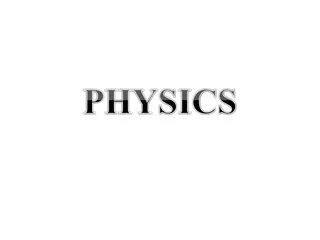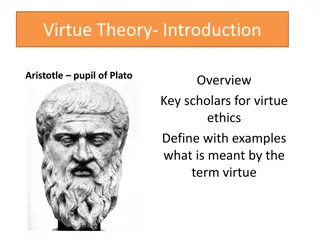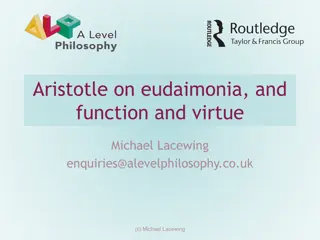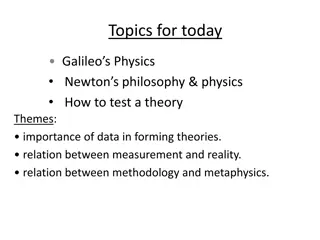Understanding Aristotle's Theory of the 4 Causes in Physics
Dig into Aristotle's theory of the 4 causes applied to inanimate objects, exploring the nature of something, the intellectual context regarding change, and the significance of causes in philosophical inquiry.
Download Presentation

Please find below an Image/Link to download the presentation.
The content on the website is provided AS IS for your information and personal use only. It may not be sold, licensed, or shared on other websites without obtaining consent from the author. Download presentation by click this link. If you encounter any issues during the download, it is possible that the publisher has removed the file from their server.
E N D
Presentation Transcript
Aristotles Physics Influences Theory of the 4 causes (applied to inanimate objects)
Method For Socrates and Plato, philosophy begins after aporia (i.e. first we have to cleanse our minds of false beliefs) For Aristotle, there is value to our beliefs Therefore, philosophy emerges out of our opinions We don t have his published works, we only have his lectures and notes
Key terms aitia means cause, reason and explanation Aristotle is trying to give reasons and explanations of living things. ta physica physics; literally means about the things of nature
Starting point of inquiry With these distinctions in place, we should look into the question of how many causes there are, and what they are like. For the main point of our investigation is to acquire knowledge, and a prerequisite for knowing anything is understanding why it is as it is in other words, grasping its primary cause. Obviously, then, this is what we have to do in the case of coming to be and ceasing to be, and natural change in general. Then, once we know the principles of these things, we can try to analyse anything we are looking into in terms of these principles. (II.3, 195b16-22)
Where does the nature of something lie? FORM FORM MATTER MATTER When wood is shaped into a bed, it takes on the form of the bed. If you bury a bed, it will send up shoots that turn into wood, not a bed. Therefore, the nature of the bed is the form, not the matter. Therefore, the nature of the bed is the matter, not the form (Antiphon).
Intellectual context for thinking about change Parmenides (Eleatics): there is no change Natural philosophers: Account for change in terms of matter E.g. everything is water, fire etc. Plato s theory of the forms: Accounts for change in terms of form But separates form from matter even though form must be used to explain matter
Preliminary notes Key point: living things have the principle of change within themselves Nothing ideological about the number 4 ( more or less all the ways 195a3) Not everything in the world has all four causes (e.g. meteorological phenomena) The causes are logical explanations of something (epistemological) Anything can be a cause of anything else: E.g. walking is the efficient cause of health; health is the final cause of walking
Four causes Material cause Formal cause Efficient cause Final cause
Material cause One way in which the word cause is used is for that from which a thing is made and continues to be made for example, the bronze of a statue, the silver of a bowl, and the genera of which bronze and silver are species. (II.3, 194b23-25)
Material cause Matter is what exists throughout the change Matter is not physical stuff Matter is potentiality (dunomis) As a concept, the material cause refers to whatever is potentially a (e.g. statue)
Formal cause A second way in which the word [cause] is used is for the form or pattern (i.e. the formula for what a thing is, both specifically and generically, and the terms which play a part in the formula) (II.3, 194b26-28).
Formal cause Formal cause is actuality (energeia) Formal cause is the form (eidos) Eidos Plato s word for the Forms; also means species Formal cause of a statue is the what it is to be a statue Form = essence
Material and formal causes Material cause Material cause Whatever is potentially the statue (what is needed to exist beforehand to bring the statue into being) Material cause is potentiality Formal cause Formal cause What it is to be a statue Formal cause is actuality Note: physical matter can be thought of as a form (e.g. molten bronze is also a form which has its own matter)
Efficient cause A third way in which the word is used is for the original source of change or rest. For example, a deviser of a plan is a cause, a father causes a child, and in general a producer causes a producer and a changer causes a change. (II.3, 194b29-31) The efficient cause is the source of change (closest to our understanding of cause).
Final cause A fourth way in which the word is used is for the end. This is what something is for, as health, for example, may be what walking is for. If asked, Why is he walking? , we reply, To get healthy , and in saying this we mean to explain the cause of his walking. And then there is everything which happens during the process of change (initiated by something else) that leads up to the end: for example, the end of health may involve slimming or purging or drugs or surgical implements; they are all for the same end, but they are different in that some are actions and some are implements. (II.3, 194b32-41)
4 causes of a table Material cause: Formal cause: Efficient cause: Final cause:
Questions 1. How do the four causes apply to living things? 2. What is the relation between the formal cause and the final cause? 3. How does Aristotle account for chance? 4. If form (eidos) is understood as species, can Aristotle account for this particular tree, chair etc.? Next lecture: Physics, books 1-3 (esp. 2)
Essay Questions 1. If the Way of Truth is true, why does Parmenides write the Way of Seeming? 2. In the Republic, does Socrates prove that it pays to be just?























